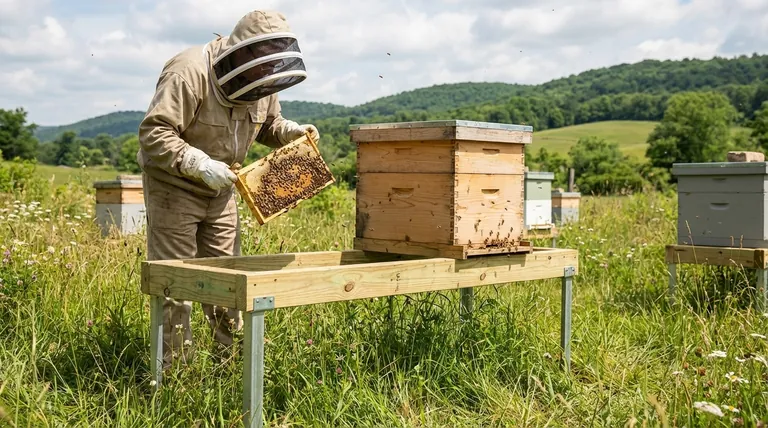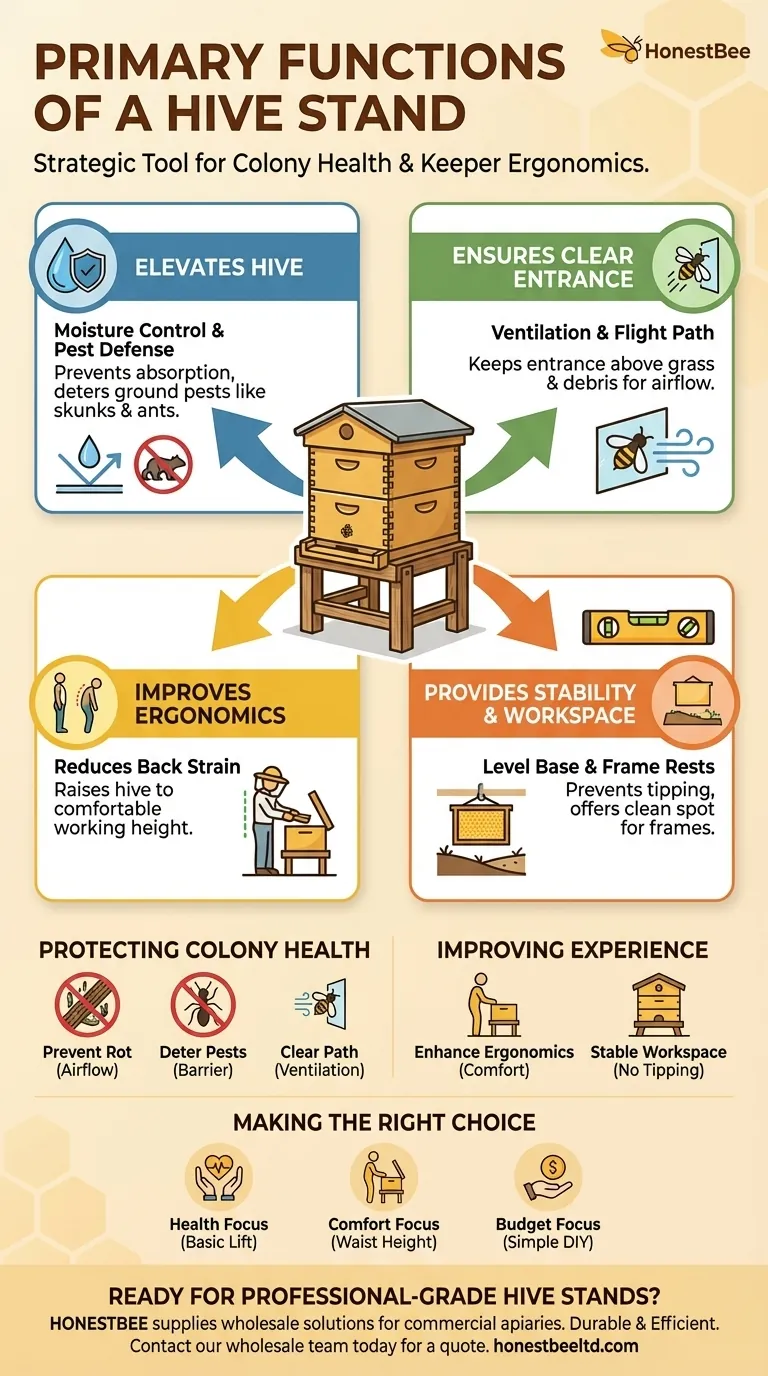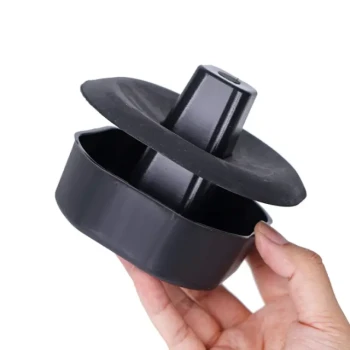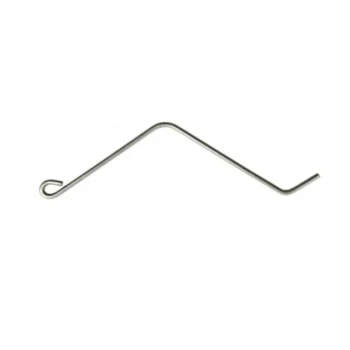The primary functions of a hive stand are to elevate the hive for moisture control and pest defense, ensure the entrance remains clear, provide a stable base, and improve ergonomics for the beekeeper. It is a foundational piece of equipment that serves the dual purpose of promoting colony health while reducing physical strain on the keeper.
While you can technically keep bees without one, a hive stand is one of the most effective, low-effort investments a beekeeper can make. It is a strategic tool that solves multiple common problems simultaneously, creating a better environment for both the bees and you.

Protecting Your Colony's Health
A hive's location and orientation have a direct impact on its well-being. A stand is the first line of defense against several environmental threats.
Preventing Moisture and Rot
A hive placed directly on the ground will absorb moisture. This constant dampness promotes wood rot, shortening the lifespan of your bottom board and creating a stressful, unhealthy environment for the bees.
By elevating the hive, even by a few inches, you allow for crucial airflow underneath. This keeps the base dry and helps the colony better regulate its internal temperature and humidity.
Deterring Pests
Elevation creates a significant barrier for many ground-based pests. It makes it more difficult for creatures like skunks, opossums, and crawling insects like ants to gain easy access to the hive entrance.
For burrowing pests or those that can climb, the stand provides a single point of entry that is easier to monitor and defend with pest control measures if needed.
Ensuring a Clear Entrance
A stand lifts the hive entrance above growing grass, weeds, and falling debris. This is not just for tidiness; it is critical for the colony's function.
An unobstructed entrance guarantees the bees a clear flight path and, more importantly, ensures proper ventilation. Blocked entrances can lead to overheating in summer and poor air exchange in winter.
Improving the Beekeeping Experience
A good hive stand doesn't just benefit the bees; it makes the entire practice of beekeeping easier and more sustainable for you.
Enhancing Ergonomics
Bending over to lift heavy hive boxes from ground level is a primary cause of back strain among beekeepers. A stand that raises the hive to a comfortable working height (typically waist-level) makes inspections and maintenance dramatically less strenuous.
This simple change can be the difference between beekeeping being a joyful hobby and a physically taxing chore.
Creating a Stable Workspace
A proper stand provides a level and stable foundation, preventing your hive from tilting or tipping over on uneven ground.
Many designs also include integrated "frame rests." These ledges give you a clean, dedicated spot to hang frames during an inspection, rather than placing them on the potentially contaminated ground.
Understanding the Trade-offs
While highly recommended, it is important to view the hive stand in context.
Is a Hive Stand Strictly Necessary?
No. Beekeepers have successfully managed colonies without purpose-built stands for centuries. However, forgoing a stand means you must actively and manually solve the problems it prevents.
This involves constant vegetation clearing, accepting a higher risk of moisture damage and pest intrusion, and enduring the physical strain of working on a ground-level hive.
Cost and Effort Considerations
Hive stands range from the simple to the elaborate. An effective stand can be made from two cinder blocks and a pair of wood beams for very little cost.
Alternatively, you can build or purchase more elegant stands that offer better ergonomics and features like built-in frame rests. The choice depends on your budget, time, and DIY skills.
Making the Right Choice for Your Apiary
The ideal hive stand is the one that best aligns with your specific goals and constraints.
- If your primary focus is colony health: Use any method, even simple cinder blocks, to get your hive at least six inches off the ground to ensure airflow and basic pest deterrence.
- If your primary focus is personal comfort: Invest in or build a stand that raises the hive's base to your waist height to completely eliminate bending and back strain.
- If your primary focus is budget: Start with a simple, effective solution like concrete blocks or stacked wooden pallets before deciding if a more expensive commercial option is necessary.
Ultimately, a hive stand is a simple but strategic decision that provides a healthier home for your bees and a more sustainable hobby for you.
Summary Table:
| Function | Benefit |
|---|---|
| Elevates Hive | Prevents moisture absorption, deters ground pests, ensures clear entrance. |
| Improves Ergonomics | Reduces back strain by raising hive to a comfortable working height. |
| Provides Stability | Creates a level, secure foundation on uneven ground. |
| Offers Workspace | Many designs include a frame rest for clean, convenient inspections. |
Ready to equip your apiary with durable, professional-grade hive stands?
As HONESTBEE, we supply commercial apiaries and beekeeping equipment distributors with wholesale-focused solutions. Our hive stands are built for durability and efficiency, helping you protect your valuable colonies and streamline your operations.
Contact our wholesale team today to discuss your needs and get a quote.
Visual Guide

Related Products
- Professional Engraved Round Hive Number Tags for Beekeeping
- Professional Ant-Proof Beehive Stand with Integrated Moat for Beekeeping
- Professional Galvanized Hive Strap with Secure Locking Buckle for Beekeeping
- HONESTBEE Professional Hive Top Bee Feeder Feeding Solution
- Endless Loop Ratchet Hive Strap
People Also Ask
- What is the best height for a hive stand? Optimize for Pest Control and Beekeeper Ergonomics
- How can hive stands be made more secure in windy areas? Anchor Your Apiary Against the Elements
- What maintenance is required for hive straps? A Guide to Cam Buckle vs. Ratchet Strap Care
- Why is it recommended to buy at least two bee hives? Boost Your Success with a Second Colony
- Why should beekeepers consider using hive stands? Protect Your Hives and Your Back



















